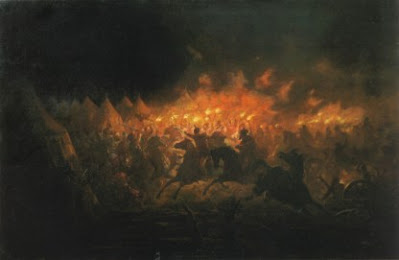Let's start at the beginning. The genesis of Bram Stoker’s Dracula is sometimes traced to the 15th Century – specifically, to 1462, when Vlad Drăculea, Voivode (Warlord) of Wallachia seized a Saxon town called Târgoviște and murdered the entire populace in the most gruesome manner imaginable. This, however, is a mistake: other than his name and his potent cocktail of aristocracy and cruelty, Drăculea lent very little to Dracula. The real genesis of Stoker’s masterpiece can perhaps be traced to the earliest German “best sellers,” many of which contained legendary accounts of Vlad’s sadism – and those accounts no doubt influenced Stoker when he was researching Dracula between 1890 and 1897 (although Stoker first heard the Vlad Drăculea legend in 1881).
Though Stoker was Irish, he lived and worked in London throughout much of the last part of the 19th Century. He always had a soft spot for an English tow n called Whitby. He often went there during his summers, and in 1890 the combination of Romanian legend, Whitby’s atmosphere (including the ruins of Whitby Abbey), and Stoker’s interest in Eastern European history began to meld. By 1897, something new – Dracula – was forged.
When discussing Stoker’s creation, I think it is helpful to
separate “Dracula,” cultural phenomenon and pillar of monsterdom, from Dracula,
the 1897 novel. In the case of the former, Francis Ford Coppola’s 1992 adaptation is
as close to the text as we’re likely to get. Other adaptations have taken significant enough liberties with
the story that they are at best cousins
to the text; some of them are little more than sad imitations of imitations. What
Hollywood Dracula took from his Wallachian inspiration and Stoker’s book is
interesting enough: the thirst for blood, the suite of mysterious powers, the
undead lifestyle (more about that in a moment), and, of course, the accent.
What Hollywood Dracula omits from the book is even more
interesting. I recently re-read Dracula (as Laughterhouse Industries' resident
Draculonomist I needed to renew my self-certification). I was quite
surprised to realize that Stoker’s Count Dracula is, in his own way, a proto- Nicolae Ceaușescu,
a ruthless Eastern European totalitarian, part of a long
and storied tradition. However, where Ceaușescu was a Communist in the tradition of Kim Il-Sung
or Joseph Stalin, Stoker’s Count Dracula was built on a framework that is
in its own way even more troubling than brute-force
class warfare. Not to put too fine a point on it (ha ha): Count Dracula was
a fascist ethno-nationalist, a child of both darkness and Aleksander
Dugin born before his time.
 |
| Symbol of the United Romanian Party, an ultranationalist political party in Romania, formerly Wallachia |
For example, there is the Count’s relationship to the literal soil of his home country. He is unable to travel without physically carrying it with him. In fact, the Count’s shipping and storage of large crates full of Wallachian earth constitute a large part of the plot of Dracula. And what is it specifically that is so valuable about this soil? Its magical qualities are explained in a passage from Jonathan Harker’s journal in which he describes his initial journey to Count Dracula’s castle. Harker sees rings of blue flame in the wilderness around him, and asks Dracula to explain the phenomenon. The Count explains how on a particular night of the year (the night of Harker’s arrival) blue flames appear over hidden treasure.
Blood and soil: or, as one particularly
odious Austrian would one day put it, Blut und Boden. The
root of Dracula’s malignant power – the source to which he must return for rest
– is the blood-drenched dirt of his homeland, a potent prediction of the cancerous madness that
would sweep Europe a few short decades later.
Dracula’s fixation on blood is not confined to the kind that
is absorbed by the thirsty Carpathian loam, either. Here is the Count
reflecting on the supposed greatness of his “race and nation”:
Dracula also rants about the past defeat and “shame of his
nation,” which transpired during a (quite
real) conflict with the Ottoman Empire:
All of the signature elements of fascism are present. Count
Dracula articulates a mythic,
Romantic sense of a “homeland” and
an ethnos. A fixation on decline, decadence, and “national shame.”
And, let’s not forget, the cult of action so
characteristic of fascist movements:
While some very good friends of mine refuse, on principle, to re-read books, I stand by my decision to occasionally reflect on texts that have deeply influenced me, the better to understand the subtleties (or, in this case, not-so-subtleties) that I might have missed the first few times around. My new perspective on Bram Stoker’s Dracula is only one example.





Comments
Post a Comment